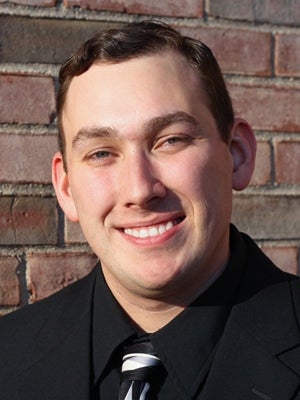Meet the Cone Institute Composers: Matthew Browne
 Matthew Browne is one of the four composers of the 2016 NJSO Edward T. Cone Composition Institute. Read a Q&A with Browne and learn more about Farthest South, which the NJSO presents as part of Scores: New Orchestral Works on July 16 at 8 pm at the Richardson Auditorium in Princeton.
Matthew Browne is one of the four composers of the 2016 NJSO Edward T. Cone Composition Institute. Read a Q&A with Browne and learn more about Farthest South, which the NJSO presents as part of Scores: New Orchestral Works on July 16 at 8 pm at the Richardson Auditorium in Princeton.
How did your musical/compositional journey begin?
I started out playing saxophone in my high-school wind ensemble and eventually began composing after one late night when a friend and I watched Fantasia (for about the 100th time). When the Rite of Spring segment came on, something just happened to finally click, and I decided I wanted to try and write something like that.
What key experiences have shaped your path as a composer?
My recently passed former teacher at the University of Colorado, Richard Tensing, asked me where I was applying for my Master of Music degree. When I ran down my list, he immediately asked why I hadn’t applied to Michigan (his alma mater), and I replied that I felt I didn’t have a strong enough portfolio to get in there. He said I was crazy and strongly urged me to apply. I ended up getting in and spent five years earning my MM and DMA from Michigan, all because of him. I later found out that on the morning of my interview at UM, he sent a very supportive email to members of the faculty.
How would you describe your compositional style, and what inspires you?
Gleefully unpredictable. I tend to get interested in many different things, musical or otherwise, and end up writing a piece about it as a way to exercise this interest. My music, as a result, ends up being a bit of a hodgepodge of different styles and impulses, rather than a uniform, easily digestible catalog of works.
What has been your proudest experience as a composer?
Last summer I attended two performances of a short string quartet of mine in a smallish town in Michigan. The first performance was for the usual adult subscriber crowd, and they loved and were very excited by the piece. The next performance was for a group of elementary- and middle-school students. Their reaction to the piece was exactly the same as the adult crowd.
What attracted you to the NJSO Edward T. Cone Composition Institute? What do you hope to gain from the experience?
I have heard wonderful things about the Institute from friends who have participated in the past, as well as tremendous things about the Orchestra and Maestro Robertson. I’m also very excited to work with Steven Mackey, whose work I admire greatly.
Farthest South: In the Composer’s Words
This piece is one of a planned series of tone poems titled Cabinet of Curiosities, inspired by fantastical tales of curious natural specimens, archeological artifacts and unique artworks that may or may not have any basis in reality.
The term farthest south refers to the most southerly latitudes reached by explorers during the so-called ‘Heroic Age’ of Antarctic Exploration prior to the conquest of the South Pole in 1911. Ernest Shackleton’s ‘Nimrod Expedition’ of 1907–09 reached a latitude of 88° 23’ S. This was, by far, the farthest south reached at that time.
What is largely unknown about this expedition, however, is the unusual encounter made by Shackleton and his company. While traversing atop Beardmore Glacier, a monumental discovery by the Nimrod Expedition (which sits at approximately 83° S, farthest south at that time), they came into view of an awesome sight; an expansive and glorious field of curious glass structures, between four and 15 feet in height. They were immaculate, crystalline, impeccably smooth and laid out with meticulous and symmetrical coordination, reminiscent of the quiet solemnity of a cemetery. When the sunlight rose above the surrounding mountain ranges and hit these fantastic monuments, a brilliant diffusive gleam of light filled the glacial valley and illuminated everything it touched with the brightest white light imaginable. Even more curious is that the arduous Antarctic weather seemed to have no erosive effect on the cleanliness of these structures, and that analysis shows that they have been sitting like this, unblemished, for the past 4,000 years. It is still unknown who built or arranged them.
It seems that a change is needed in the farthest south record book.
About the Composer
Composer Matthew Browne incorporates into his music such eclectic influences as the timbral imagination and playfulness of György Ligeti, the shocking and humorous eclecticism of Alfred Schnittke and the relentless rhythmic energy of Igor Stravinsky. His music has been called “compelling” (Milwaukee Journal Sentinel) and “beautifully crafted and considered” (What’s On London). The Burlington, Vermont, native has collaborated with the Minnesota Orchestra, Albany and Milwaukee symphonies, Alarm Will Sound, New England Philharmonic, PUBLIQuartet, SEVEN)SUNS and the Villiers String Quartet and Donald Sinta and Tesla quartets.
His music has received honors such as an ASCAP Morton Gould Young Composers Award, BMI Student Composer Award and Special Distinction in the ASCAP Foundation Rudolf Nissim Prize; he won the New England Philharmonic Call for Scores and the American Viola Society’s Maurice Gardner Composition Award, and he has had residencies at the Mizzou International Composers Festival, Minnesota Orchestra Composer Institute and Milwaukee Symphony Orchestra’s MSO Composer Institute. He holds a Doctorate of Musical Arts in Music Composition from the University of Michigan-Ann Arbor and a Bachelor of Music from the University of Colorado at Boulder. Previous teachers include Michael Daugherty, Kristin Kuster, Carter Pann and Daniel Kellogg.